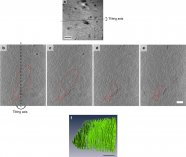The definition of nano-composite material has broadened significantly to encompass a large variety of systems such as one-dimensional, two-dimensional, three-dimensional and amorphous materials, made of distinctly dissimilar components and mixed at the nanometer scale.
The general class of nanocomposite organic/inorganic materials is a fast growing area of research. Significant effort is focused on the ability to obtain control of the nanoscale structures via innovative synthetic approaches. The properties of nano-composite materials depend not only on the properties of their individual parents but also on their morphology and interfacial characteristics.
This rapidly expanding field is generating many exciting new materials with novel properties. The latter can derive by combining properties from the parent constituents into a single material. There is also the possibility of new properties which are unknown in the parent constituent materials.
The inorganic components can be three-dimensional framework systems such as zeolites, two-dimensional layered materials such as clays, metal oxides, metal phosphates, chalcogenides, and even one-dimensional and zero-dimensional materials such as (Mo
3Se3-)n chains and clusters. Experimental work has generally shown that virtually all types and classes of nanocomposite materials lead to new and improved properties when compared to their macrocomposite counterparts. Therefore, nanocomposites promise new applications in many fields such as mechanically reinforced lightweight components, non-linear optics, battery cathodes and ionics, nano-wires, sensors and other systems.The general class of organic/inorganic nanocomposites may also be of relevance to issues of bio-ceramics and biomineralization in which in-situ growth and polymerization of biopolymer and inorganic matrix is occurring. Finally, lamellar nanocomposites represent an extreme case of a composite in which interface interactions between the two phases are maximized. Since the remarkable properties of conventional composites are mainly due to interface interactions, the materials dealt with here could provide good model systems in which such interactions can be studied in detail using conventional bulk sample (as opposed to surface) techniques. By judiciously engineering the polymer-host interactions, nanocomposites may be produced with a broad range of properties.
Inorganic layered materials exist in great variety. They possess well defined, ordered intralamellar space potentially accessible by foreign species. This ability enables them to act as matrices or hosts for polymers, yielding interesting hybrid nano-composite materials.
Lamellar nano-composites can be divided into two distinct classes, intercalated and exfoliated. In the former, the polymer chains alternate with the inorganic layers in a fixed compositional ratio and have a well defined number of polymer layers in the intralamellar space. In exfoliated nano-composites the number of polymer chains between the layers is almost continuously variable and the layers stand >100 Å apart. The intercalated nano-composites are also more compound-like because of the fixed polymer/layer ratio, and they are interesting for their electronic and charge transport properties. On the other hand, exfoliated nano-composites are more interesting for their superior mechanical properties.







